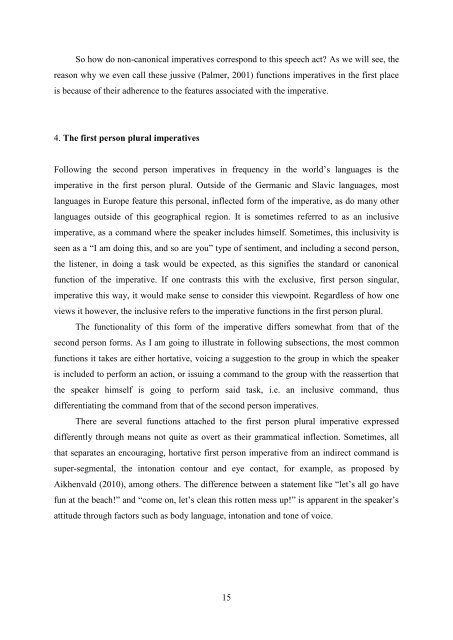The function of non-canonical imperatives in the languages of Europe
The function of non-canonical imperatives in the languages of Europe
The function of non-canonical imperatives in the languages of Europe
Create successful ePaper yourself
Turn your PDF publications into a flip-book with our unique Google optimized e-Paper software.
So how do <strong>non</strong>-ca<strong>non</strong>ical <strong>imperatives</strong> correspond to this speech act As we will see, <strong>the</strong><br />
reason why we even call <strong>the</strong>se jussive (Palmer, 2001) <strong>function</strong>s <strong>imperatives</strong> <strong>in</strong> <strong>the</strong> first place<br />
is because <strong>of</strong> <strong>the</strong>ir adherence to <strong>the</strong> features associated with <strong>the</strong> imperative.<br />
4. <strong>The</strong> first person plural <strong>imperatives</strong><br />
Follow<strong>in</strong>g <strong>the</strong> second person <strong>imperatives</strong> <strong>in</strong> frequency <strong>in</strong> <strong>the</strong> world’s <strong>languages</strong> is <strong>the</strong><br />
imperative <strong>in</strong> <strong>the</strong> first person plural. Outside <strong>of</strong> <strong>the</strong> Germanic and Slavic <strong>languages</strong>, most<br />
<strong>languages</strong> <strong>in</strong> <strong>Europe</strong> feature this personal, <strong>in</strong>flected form <strong>of</strong> <strong>the</strong> imperative, as do many o<strong>the</strong>r<br />
<strong>languages</strong> outside <strong>of</strong> this geographical region. It is sometimes referred to as an <strong>in</strong>clusive<br />
imperative, as a command where <strong>the</strong> speaker <strong>in</strong>cludes himself. Sometimes, this <strong>in</strong>clusivity is<br />
seen as a “I am do<strong>in</strong>g this, and so are you” type <strong>of</strong> sentiment, and <strong>in</strong>clud<strong>in</strong>g a second person,<br />
<strong>the</strong> listener, <strong>in</strong> do<strong>in</strong>g a task would be expected, as this signifies <strong>the</strong> standard or ca<strong>non</strong>ical<br />
<strong>function</strong> <strong>of</strong> <strong>the</strong> imperative. If one contrasts this with <strong>the</strong> exclusive, first person s<strong>in</strong>gular,<br />
imperative this way, it would make sense to consider this viewpo<strong>in</strong>t. Regardless <strong>of</strong> how one<br />
views it however, <strong>the</strong> <strong>in</strong>clusive refers to <strong>the</strong> imperative <strong>function</strong>s <strong>in</strong> <strong>the</strong> first person plural.<br />
<strong>The</strong> <strong>function</strong>ality <strong>of</strong> this form <strong>of</strong> <strong>the</strong> imperative differs somewhat from that <strong>of</strong> <strong>the</strong><br />
second person forms. As I am go<strong>in</strong>g to illustrate <strong>in</strong> follow<strong>in</strong>g subsections, <strong>the</strong> most common<br />
<strong>function</strong>s it takes are ei<strong>the</strong>r hortative, voic<strong>in</strong>g a suggestion to <strong>the</strong> group <strong>in</strong> which <strong>the</strong> speaker<br />
is <strong>in</strong>cluded to perform an action, or issu<strong>in</strong>g a command to <strong>the</strong> group with <strong>the</strong> reassertion that<br />
<strong>the</strong> speaker himself is go<strong>in</strong>g to perform said task, i.e. an <strong>in</strong>clusive command, thus<br />
differentiat<strong>in</strong>g <strong>the</strong> command from that <strong>of</strong> <strong>the</strong> second person <strong>imperatives</strong>.<br />
<strong>The</strong>re are several <strong>function</strong>s attached to <strong>the</strong> first person plural imperative expressed<br />
differently through means not quite as overt as <strong>the</strong>ir grammatical <strong>in</strong>flection. Sometimes, all<br />
that separates an encourag<strong>in</strong>g, hortative first person imperative from an <strong>in</strong>direct command is<br />
super-segmental, <strong>the</strong> <strong>in</strong>tonation contour and eye contact, for example, as proposed by<br />
Aikhenvald (2010), among o<strong>the</strong>rs. <strong>The</strong> difference between a statement like “let’s all go have<br />
fun at <strong>the</strong> beach!” and “come on, let’s clean this rotten mess up!” is apparent <strong>in</strong> <strong>the</strong> speaker’s<br />
attitude through factors such as body language, <strong>in</strong>tonation and tone <strong>of</strong> voice.<br />
15
















